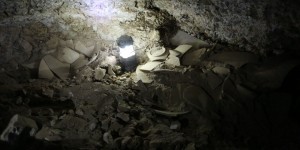Archaeologists believe they have discovered a 12th cave of Dead Sea Scrolls, adding to the treasure trove of history attained in the first eleven caves of Wadi Qumran.
Prior to the Dead Sea Scrolls, the earliest version of the Old Testament known to man was the Aleppo Codex, which was dated approximately to 930 Common Era (CE). When teenagers stumbled upon the scrolls while exploring jagged caves in the Judean desert in the late 1940s, they had no idea they would to push that timeline by a millennium, to the second century BCE.
Since then the eleven caves have been the subject of exhaustive archaeological study. Now, the Israeli Hebrew University and the Virginia-based Liberty University have discovered what archaeologist Oren Gutfeld calls “one of the most exciting archaeological discoveries, and the most important in the last 60 years, in the caves of Qumran,” in the form of a new cave.
While this is the first time archaeologists have found cave, it’s clear that, as with the original eleven, locals at one point had a deeper knowledge of this place. Excavation of the cave revealed 2nd century BCE storage jars and lids, but these were all broken and their contents removed. The discovery of a iron pickaxe heads from the 1950s offer proof the cave was looted.
“Although at the end of the day no scroll was found,” Gutfield says, “and instead we ‘only’ found a piece of parchment rolled up in a jug that was being processed for writing, the findings indicate beyond any doubt that the cave contained scrolls that were stolen. The findings include the jars in which the scrolls and their covering were hidden, a leather strap for binding the scroll, a cloth that wrapped the scrolls, tendons and pieces of skin connecting fragments, and more.”
You have to wonder: Where are the scrolls of the 12th cave? Says Israel Hasson, director-general of the Israel Antiquities Authority: “We are in a race against time as antiquities thieves steal heritage assets worldwide for financial gain.”
Ask me anything
Explore related questions






